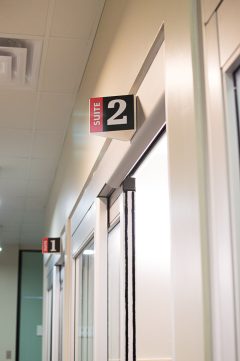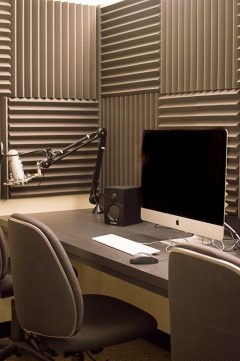
By Cassandra Hendry, TLS staff writer
Paul Jasen, an instructor in Carleton’s communications and music departments, often hears that students in arts-based courses want to graduate with hands-on, tangible skills. Employers are searching for potential hires that are able to code a website, use Photoshop, or create professional-quality videos.
Luckily, Jasen says, Carleton has a hub on campus that can provide students those types of skills.
The Media Commons on the sixth floor of Southam Hall is one of the university’s best kept secrets, giving students, staff and instructors the opportunity to create professional multimedia projects. But it’s far more than just an area to rent video equipment or record audio; it’s a hub of learning.
“What the Media Commons does is that it teaches students. A typical history student has never used a camera professionally and doesn’t know much about the technique of editing,” says Michael Ostroff, an instructor in film and history.
“Through workshops and having the staff there when there are problems, students have become very proficient in using the equipment and learning the techniques of telling a story.”
Both Jasen and Ostroff’s students make use of the Media Commons for two distinct reasons.
 Jasen’s course on podcasting has regularly scheduled classes in the radio editing suites of the River Building. He found that students wanted more than a few hours per week to work on their podcasts, so he reached out to the staff at the Media Commons. His students were able to use the hub’s high-quality microphones, specialized software, and acoustically treated rooms while receiving professional audio recorders on loan to record audio around Ottawa.
Jasen’s course on podcasting has regularly scheduled classes in the radio editing suites of the River Building. He found that students wanted more than a few hours per week to work on their podcasts, so he reached out to the staff at the Media Commons. His students were able to use the hub’s high-quality microphones, specialized software, and acoustically treated rooms while receiving professional audio recorders on loan to record audio around Ottawa.
“That was key because it got them out of the studio and out into the world, where they then could bring the world back into their podcasts,” Jasen says.
In Ostroff’s two courses on documentary making—one in the history department and the other in film—he found his students benefited the most from the support they received from the Media Commons staff.
“It’s crucial what this facility offers [these courses] . . . What’s most important is the people who work there. You can have all the equipment in the world, but you need to have people who are capable of working with and teaching students. I teach the students the aesthetics but I don’t teach them what buttons to push,” Ostroff says.
He finds that his students get so excited about the documentaries they’re making and the high quality of work they’re producing that sometimes they work 60 to 80 hours editing these projects in the Media Commons. In fact, one student group in his history course may have their documentary on the effort to bring 4,000 Vietnamese refugees to Ottawa purchased by the CBC.
“There’s magic in movies. And [students] can make magic when they’re not fighting the equipment. It makes a huge difference,” he says.
Olivia Dendy, a student in Ostroff’s film studies course, says though she was familiar with basic editing software such as Windows MovieMaker and iMovie, she had limited experience with more professional software.
During the course, Media Commons staff taught Dendy to use high-quality cameras and editing software. She was also able to make use of the on-hand staff throughout the shooting and editing processes to brainstorm helpful solutions.
“I learned so much using the Media Commons . . . We learned how to work as a group in an entirely non-academic way, which I think will be hugely beneficial in a career setting,” she says.
To learn more about the Media Commons and how it can be used for your multimedia teaching and learning needs, visit the Media Production Centre’s website.